Monogram/Encore 1/48 F-102A "Case XX" wing. 196th FIS California ANG
History:
What became the F-102 marked a major change in design and development of fighters. It was the result of a recommendation made on October 8,1948, by the Air Force Senior Officers Board that the service organize a competition for a new interceptor that would enter service in 1954; on February 4, 1949, the USAF approved the recommendation and announced a competition to be held in 1950 for what was then called the "1954 Ultimate Interceptor." In November 1949, it was decided the new aircraft would be built around a fire-control system (FCS) that would be designed before the airframe to ensure compatibility; the project became known as a “weapon system.
Air Materiel Command issued request for proposals regarding the fire control system in January 1950 to 50 companies, of which 18 responded. In May, the list was reduced to ten, which were reviewed by the Air Defense Engineering Committee. Following recommendations by the committee, the proposals were reduced to two competitors, Hughes Aircraft and North American Aviation. Hughes was chosen to develop the fire control system on October 2,1950.
An RFP for the airframe was issued on June 18, 1950; six manufacturers responded in January 1951. On July 2, 1954, Convair, Republic and Lockheed were awarded contracts for a mockup. Convair based its proposal on the company's previous work designing and flying the XF-92 delta wing research aircraft, In November, Convair was awarded a contract to develop its Model 8-80 as the “XF-102" as the airframe component of "Project MX-1554". In the end, Convair emerged as the victor with its design,
Originally, the design was to be powered by the Allison J-40, which turned out to be the worst turbojet design in US aviation history. Fortunately, Pratt and Whitney's marvelous J-57 arrived on the scene just in time. Continued delay in the MA-1 fire control system to the decision to go with an interim aircraft using the simpler E-9 fire control system as the F-102A, while the fully developed MA-1 system would be used in the F-102B that would be powered by the Curtiss-Wright J67, licensed derivative of the Bristol-Siddeley Olympus, This ultimately became the F-106A.
The prototype YF-102 flew for the first time on at Edwards AFB on October 23. 1953; it was lost in an accident nine days later. The second prototype flew on 11 January 1954, confirming that transonic drag was much higher than expected, making the airplane permanently subsonic with a maximum speed of Mach 0.98 with a maximum ceiling of 48,000 feet, far below what was required.
Convair was saved by the publication of Richard Whitcomb's “area rule” for supersonic flight design. Adopting the rule, the XF-102's fuselage was lengthened by 11 feet and "pinched" at the midsection with two large fairings on either side of the engine nozzle, giving the airframe what was soon popularized as the "Coke Bottle configuration" with revised intakes and a new, narrower canopy. A more powerful model of the J57 was fitted, and the aircraft structure was lightened. Additionally, the wing was redesigned to be thinner with increased span. The leading edge was given a conical droop, with the apex at the root, to improve handling at low speeds. Because the droop remained within the shock cone of the leading edge, the drag rise at supersonic speeds was minimal.
The first revised prototype, designated YF-102A flew 118 days after redesign began, on December 20, 1954; the next day it exceeded Mach 1. Further testing demonstrated a top speed of Mach 1.22 and a maximum ceiling of 53,000 ft. When the YF-102As successfully intercepted a B-36 at its maximum altitude, Convair's improvements were deemed sufficient for the Air Force to authorize production of the F-102 in March 1954.
Production F-102As were equipped with the Hughes MC-3 fire control system, later upgraded to the MG-1, armed with six AIM-4 Falcon missiles divided between infrared homing 9AIM-4A)and semi-active radar homing (AIM-4D) variants. Unfortunately, the Falcon was the worst AAM the Air Force developed; fortunately, the F-102A's opponent - Soviet intercontinental nuclear bombers - didn't exist. Total production of 889 F-102As was completed in September 1968.
The F-102A first entered service in 1956 with the 327th FIS at George AFB. They were deployed throughout the continental US in ADC, in Europe with USAFE and the Pacific with PACAF by 1960. In 1964, F-102As were deployed to DaNang, South Vietnam, to provide air defense against possible attack by VPAF Il-28s. The aircraft were also used in ground attack and to escort B-52s. One was shot down by a VPAF MiG-21 using an Atoll missile on February 3, 1968. Two were shot down while conducting CAS missions, four were blown up by VC sapper teams, and eight were lost to engine failure and other operational accidents. Air National Guard units operated F-102s between 1965-76, when the aircraft left service for modification as full-size drone missile targets.
The Kit:
Monogram first released their 1/48 F-102A with the “Case X” early wing in 1990. The kit was re-released in 1995 with the Case XX wing under the ProModeler label. Re-releases of the Case XX model happened in 2000, 2002, and by Revell in 2004 and 2016. In 2010, Squadron released an “Encore” kit with the kit plastic and resin sets for the cockpit, control surfaces and missiles.
The F-102A has been released in 1/72 by Hasegawa in the 1960s with a kit that is quite primitive by modern standards, and by Meng released a Case X wing F-102A in 2012, followed the next year by a Case XX wing kit. This is fully up to modern standards.
Numerous aftermarket decal sheets were released over the years for the Monogram kit. After Monogram's 2–4 release, which included decals for the California ANG 196th FIS, SuperScale released a sheet with both Case X and Case XX F-102As of that unit in 2010 at the time of the Encore release.
Construction:
Monogram kits are famous for being simple in construction design, and this kit is no different. Fit has always been an issue, however. With this kit, the main fit problem is in the fit of upper and lower wing parts, since the lower part fits into the curved leading edge which is on the upper part. I found that by sanding the interior of the lower part and carefully test-fitting that I could get the fit sufficiently tight that only a bit of filler was needed. After sanding it smooth, I rescribed the detail that had been lost. I also did this with fitting the fuselage halves together; I was able to sand the inset right side to the point it fit without need of filler.
With these Encore kits, much of the resin isn't usable. That was the case with the flaperons, which were not of sufficient span. I therefore kept the plastic parts and opted to sand them down to a proper trailing edge. I did use the rudder with the vertical fin.
The resin cockpit tub was useless, being too wide to fit without a lot of grinding down, I opted to stick with the plastic part and use the resin instrument panel and coaming, which meant I had to cut out the coaming on either fuselage half. The photoetch instrument panel was a definite improvement from the kit part. I combined the resin and plastic of the control stick, using the resin upper part mated to the plastic base. The resin ejection seat was a vast improvement and I used it without problem.
I used the plastic nose cone since the resin part was mis-shaped and also a bit small in diameter to the fuselage. This allowed me to put weights inside the cone; with some additional weights inside ahead of the cockpit tub and wheel well, the model became a guaranteed nose-sitter.
The fuselage and wing sub-assemblies came together without problem and I only had to use some filler for the lower rear fuselage wing/fuselage joint.
I decided to use the open weapons bay due to the fact the plastic option for the closed doors didn't fit well. I cleaned up the plastic launchers and went with the resin missiles, which again were a vast improvement on the kit part.
Colors and Markings:
When I read the decal instructions which stated that the Case XX wing option for the 196th FIS was painted overall aluminum lacquer, I wasn't sure of that, However, when I asked google to show me photos of 196th FIS F-102A, the first three color photos showed the aluminum callout was correct.
I gave the model an overall primer coat of Tamiya X-18 Semi-gloss Black, then masked off the radome and the weapons bay, and gave the model an overall coat of Vallejo Semi-Matte Aluminum, which looked perfect after it dried. I painted the exhaust area with Vallejo Dark Aluminum and the leading edge of the intakes with Vallejo Duraluminum.
The Encore kit decals are printed by Cartograf and were excellent. I combined the two sheets, using the national insignia and US Air Force and USAF decals from the kit sheet since they were the correct shade of dark blue, with the SuperScale sheet used for the 196th FIS markings and serial number. I also used the SuperScale stencil decals.
I used the resin wheels for the landing gear, which I then assembled and attached. I attached the drop tanks and positioned the canopy in the raised position. I attached the parabrakes in the open position.
Conclusions:
The model came out much better than expected. It's unlikely that another 1/48 F-102A will come along soon, and if it does it will be much more expensive than the old Monogram. However, Monogram's Century Series make up into good kits if one takes time and treats the parts like they were a limited-run kit. I've liked the F-102A since I was a kid, and this is a good addition to the collection.
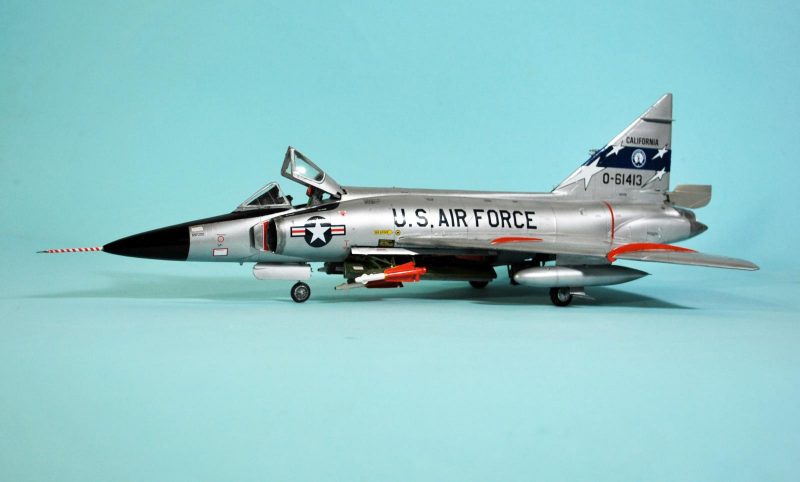
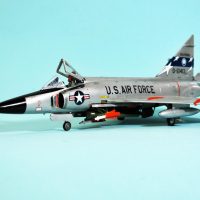
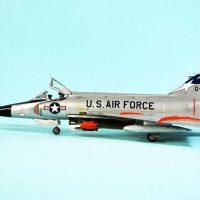

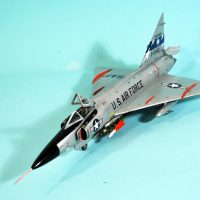

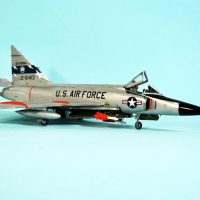
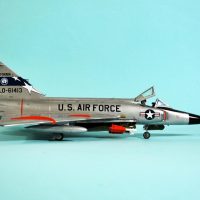

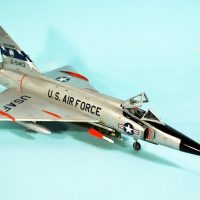
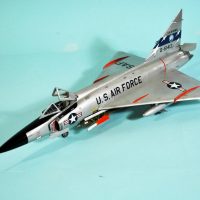
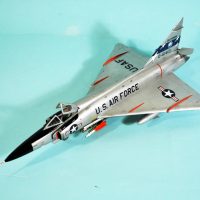
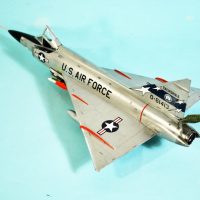
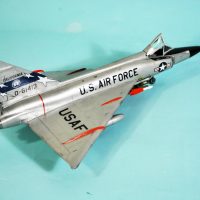
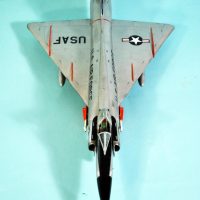
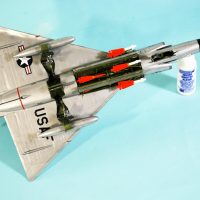

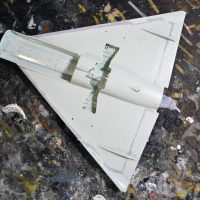
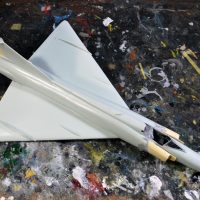
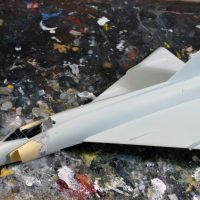
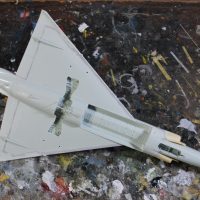
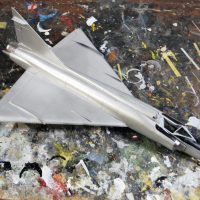
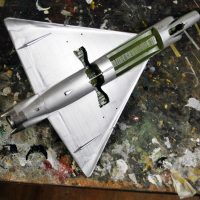
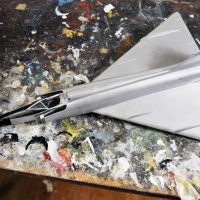
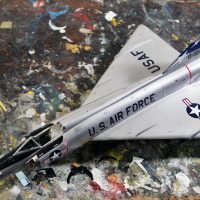
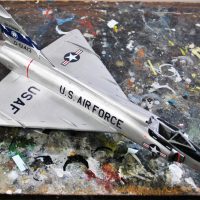
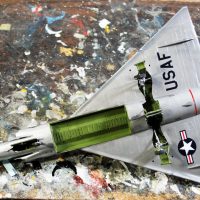
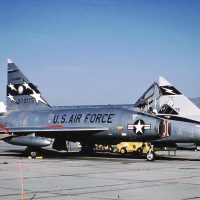
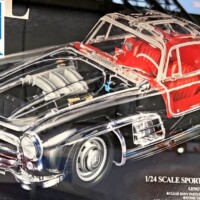
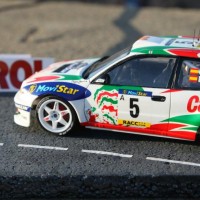

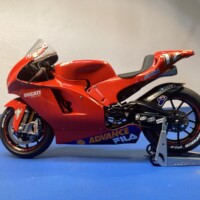
Good stuff Tom and thanks for the wing info. I knew there was an issue here but some builders seem to really to be making a mountain out of some kind of small burrowing mammal residence. One in the stash
Very nicely done Tom, my compliments. I have one on the modeling table now that will be finished in SC ANG markings. Those Monogram Century series jets still have a lot going for them. Thanks for posting your fine California Air National Guard Deuce.
Very nice this, Tom. I'm surprised at how good you've made the Vallejo lacquer look, and the decal application is superb. The real surprise in this post (for quirky mois), is your work/paint bench surface... the wondrous blotches of vivid colors just scream- Vincent's palette!
Anyway, a very lovely Delta.
"A neat desk is the sign of a sick mind." 🙂
I have this kit in the stash, too. Disappointed that all the nice looking resin don't amount to much (but I got the kit for a discount so...)
The NMF painted look really worked out here also because it isn't as common as the ADC grey ones. I'm planning to make the Encore kit I own into a similar scheme from the 57th FIS out of Keflavik.
However, the resin that is good is very worthwhile, and the plastic you'll use isn't that bad.
This one turned out so sharp, Tom. That CA ANG scheme is one of my favorites.
Beautiful Deuce Tom. I was a tot when we stationed at Elmendorf AFB in Anchorage Alaska from 1957 to 1960. Still remember them blasting overhead.
What dreams they inspired.
A great job on this cold war mount, unusual in the aluminum paint scheme.
Great job and amazing result, on the venerable Monogram, Tom!
What an inspiration to build mine!
Great result on this Dagger, Tom
The aluminum, like the rest of the build, does look superb.
Thanks for the history background, very informative.
Tidy looking build Tom. The Vallejo works very well for the aluminium lacquer. I have a soft spot for Monogram kits and your build reinforces it.
Oohh..Very nice. Really I liked it. This 102 with same markings was already in my bucketlist.
Grande lavoro Tom...aereo Fantastico ,specialmente con la colorazione alluminium lacquer...?
The F-102 is one of my all-time favorites! Regrettably...I never had the chance to see one fly. Thanks for sharing, Tom!
Big fan of these Centuries Jets. This build makes them justice. Congrats!
Hello Tom,
Great machine. Monogram, very reliable construction.
You did a magnificent job. (including the pics.)
Regards, Dirk
Beautiful F-102, Tom. I like the unusual aluminum finish and markings. Puts me in the mood to do my Monogram F-106, still unsurpassed by the Trumpeter kit (which has - sigh - significant shape problems for all its detail).
Very nice model A’s story Tom.
Why did we not continue with Delta wings I wonder. France did to great success with the Mirage
Beautiful102 Tom! Excellent narrative and photos. Two thumbs up!
Very nice build and write up, Tom. An aside to the combat loss during the Vietnam war...from the book Vietnam Air Losses...1Lt Wiggins was the wingman in a two-ship flying out of Udorn. They were jumped near the Laos/North Vietnamese border by two MiG 21's after which Wiggins told his leader that his "jet was flying funny". After a visual inspection by his flight lead, he was told that he had an unexploded ATTOLL stuck in the tail of his jet. A bit later, they were attacked by two more MiG 21's and he was shot down during that engagement.
Hi Tom. Your F-102 is pure eye candy. It shines in all the right places. Having built this kit before and with a 2nd under construction I too can echo your sentiments regarding the Monogram Dagger. I love these old Monogram Century series models. Thanks for posting yours!
Awesome work Tom, I'm a huge fan of the Convair Delta's. But I'm partial to the F-106, which I watched when visiting the grand folks in Fresno way back when.
Yeah, the 106 is awesome. When I was up at George AFB 40 years ago this month to do an article on the Wild Weasels, there were two 196th FIS 106s there, and they pulled an alert. The only more spectacular takeoff I ever saw was the Skyrays of VF(aw)-3 at North Island. Those 106s tore down that runway and pulled up close to vertical and they were gone!
Awesome build, Tom (tcinla). It was great following along in WIP.
A great-looking 102! You've really got the handle on using those Vallejo metallics - I'm also getting good results from them.
It's nice to be able to paint metallics without someone else complaining about the stench. 🙂
It's magnificent! One of the best F-102 I've seen so far!
Fantastic model Tom, and very timely as well. I've had this kit (original XX) in the stash for 30+ years and I'm finally building it. I'm closing up the missile bay in order to speed things along. Like you, I chose the painted aluminum finish, but that of the Idaho Air Guard birds. I'm not sure which paint I'll use, perhaps Humbrol metal Cote matte aluminum? Thanks so much for the inspiration! I've always loved those big deltas, and the F-106 is also in the "pile" (along with the F-105 Monogram). 🙂